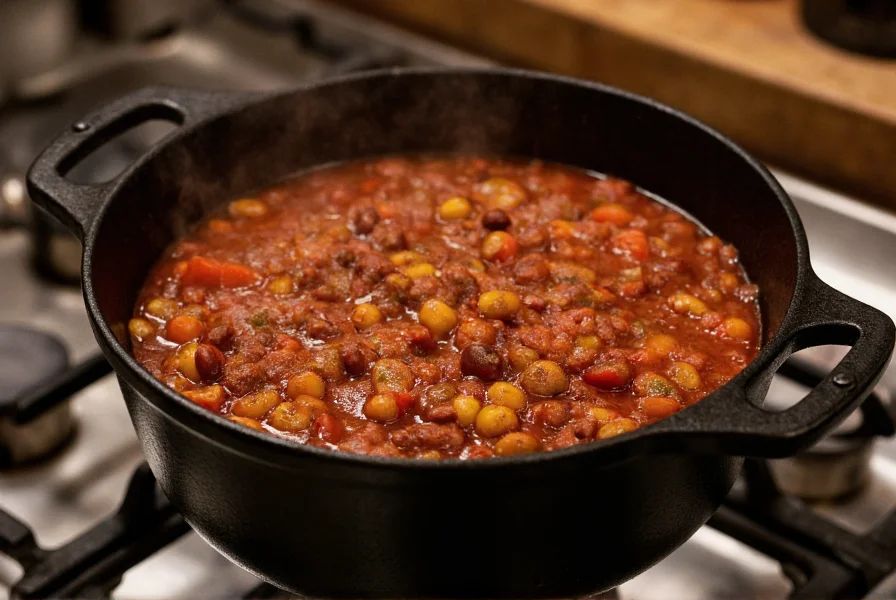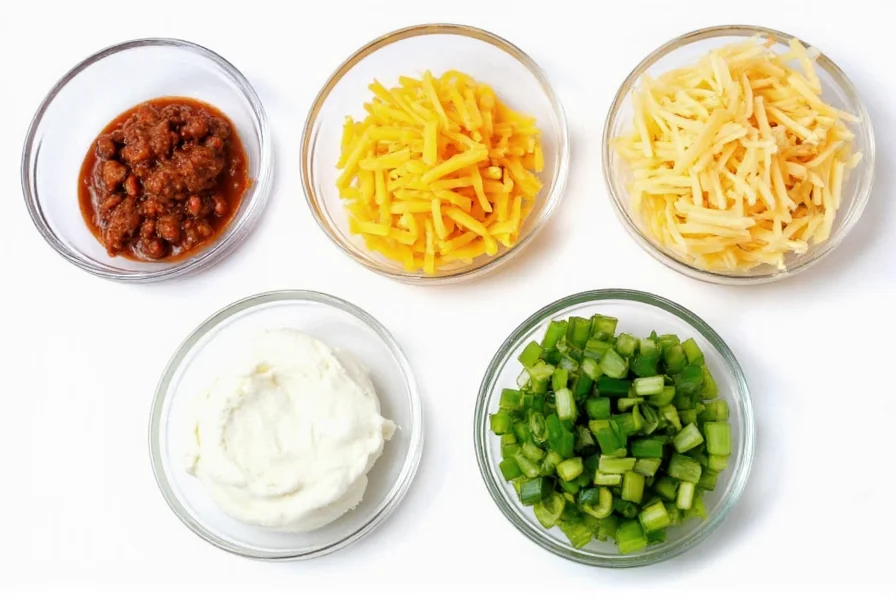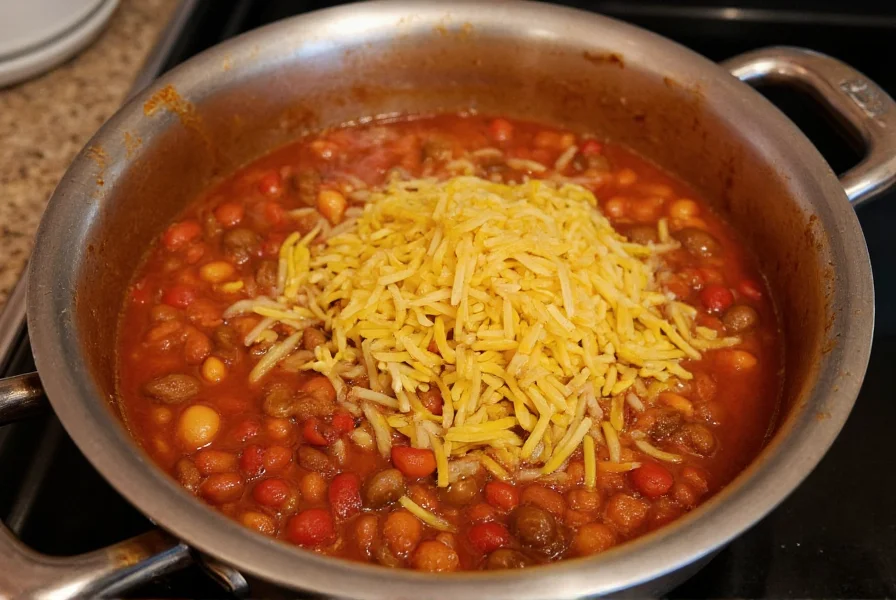Perfect stovetop chili balances rich meatiness, smoky spices, and just the right thickness. The stove's direct heat creates ideal conditions for the Maillard reaction when browning meat, while gentle simmering extracts maximum flavor from tomatoes, beans, and spices. This hands-on approach lets you adjust seasoning and texture throughout cooking—a distinct advantage over set-it-and-forget-it methods.
Essential Ingredients for Authentic Stovetop Chili
Building exceptional stovetop chili starts with quality ingredients. While regional variations exist, these components form the foundation of a classic recipe that simmers beautifully on your stove:
| Ingredient Category | Key Components | Why It Matters for Stovetop Cooking |
|---|---|---|
| Meat Foundation | Chuck roast (1.5" cubes), ground beef, optional bacon | Proper browning on stove develops complex flavors through controlled heat |
| Aromatic Base | Yellow onions, garlic, bell peppers | Slow cooking on stove releases natural sugars without burning |
| Tomato Component | Crushed tomatoes, tomato paste | Simmering concentrates flavors better than electric appliances |
| Bean Selection | Kidney beans, pinto beans (canned, drained) | Added late in stovetop process prevents mushiness |
| Spice Profile | Chili powder, cumin, smoked paprika, cayenne | Gradual incorporation builds layered heat during simmering |
Optimal Equipment for Stovetop Chili Preparation
Your choice of pot significantly impacts results when making chili on the stove. A heavy-bottomed Dutch oven (6-8 quarts) distributes heat evenly, preventing hot spots that cause scorching during the extended simmering time. Cast iron or enameled cast iron retains heat beautifully, while stainless steel with aluminum core offers excellent temperature control. Avoid thin pots that create uneven cooking—essential for how to make chili on stove without burning.
Essential tools include a wooden spoon for stirring (metal can scratch cookware), a slotted spoon for removing meat during browning, and a fine-mesh strainer for rinsing beans. Having these items ready streamlines the traditional stovetop chili cooking process from start to finish.

Step-by-Step Stovetop Chili Method
The magic of stovetop chili recipe with ground beef happens through careful layering of cooking stages. Begin by patting 2 pounds of chuck roast cubes completely dry—moisture prevents proper browning. Heat 2 tablespoons of oil in your Dutch oven over medium-high heat until shimmering. Working in batches to avoid crowding, sear meat on all sides until deeply browned (about 8 minutes per batch). Remove meat and set aside.
Reduce heat to medium and add 2 diced onions, 1 diced bell pepper, and 4 minced garlic cloves. Cook for 8-10 minutes until softened and beginning to caramelize. Push vegetables to the side and add 1 tablespoon tomato paste, cooking until it darkens slightly (about 2 minutes)—this stovetop chili flavor development technique creates incredible depth.
Return meat to the pot along with accumulated juices. Stir in 3 tablespoons chili powder, 2 teaspoons cumin, 1 teaspoon smoked paprika, and ½ teaspoon cayenne. Cook for 1 minute until fragrant. Add 28 ounces crushed tomatoes, 1 cup beef broth, and 1 tablespoon apple cider vinegar. Bring to a gentle simmer, then reduce heat to low.
Cover partially and simmer for 60-90 minutes, stirring occasionally, until meat is fork-tender. During the last 15 minutes, add 2 drained cans of beans. The ideal stovetop chili cooking time varies based on your stove's heat output—adjust as needed to maintain a gentle bubble without vigorous boiling.
Avoiding Common Stovetop Chili Mistakes
Many home cooks encounter issues with how to cook chili on stove top that compromise results. The most frequent error is rushing the browning process—crowding the pot lowers temperature and steams rather than sears meat. Another common issue is adding beans too early, causing them to disintegrate during extended simmering.
Stirring too frequently interrupts the gentle simmer needed for flavor development. Resist the urge to lift the lid constantly—this releases precious steam that helps tenderize the meat. If your chili sticks despite careful heat management, you likely need a heavier pot or should reduce heat further. The ideal stovetop chili consistency should coat the back of a spoon but still flow slowly.
Customizing Your Stovetop Chili Recipe
One advantage of making chili on stove is the ability to adjust throughout cooking. For smokier depth, add 1-2 chipotle peppers in adobo sauce. Prefer white chili? Substitute chicken thighs for beef and use white beans with green chilies. Vegetarian? Use portobello mushrooms and textured vegetable protein with vegetable broth.
For thicker chili without compromising flavor, create a slurry of 2 tablespoons masa harina and ¼ cup broth, stirring it in during the last 15 minutes. Want to reduce acidity? A teaspoon of brown sugar balances tomato sharpness perfectly. These adjustments showcase why stovetop chili vs slow cooker offers superior control for personalized results.

Serving and Storage Recommendations
Stovetop chili tastes best after flavors have time to meld. Let it rest off-heat for 15-20 minutes before serving to allow flavors to integrate fully. For optimal stovetop chili serving temperature, maintain 165°F when serving—use a thermometer to verify.
Store leftovers in airtight containers within 2 hours of cooking. Properly refrigerated, chili keeps for 4-5 days. For longer storage, freeze in portion-sized containers for up to 3 months. When reheating stovetop chili leftovers, do so gently over medium-low heat with a splash of broth to restore ideal consistency.
Frequently Asked Questions
How long should chili simmer on the stove for best flavor?
For optimal flavor development in stovetop chili, simmer for 60-90 minutes after bringing to a gentle boil. This extended cooking time allows collagen in meat to break down completely while flavors meld. Check periodically and add small amounts of broth if chili becomes too thick. The ideal simmer shows small bubbles breaking the surface every 10-15 seconds.
Can I make chili on an electric stove top?
Yes, you can make excellent chili on an electric stove top with proper technique. Electric coils take longer to heat and cool, so use medium heat for simmering rather than low. Choose a heavy-bottomed pot for even heat distribution. When browning meat, ensure the surface is properly preheated before adding oil—test with a drop of water that should sizzle immediately. Monitor closely as electric elements maintain heat longer after adjustment.
Why does my stovetop chili stick to the bottom of the pot?
Chili sticks primarily due to excessive heat or insufficient liquid. Maintain a gentle simmer rather than a rolling boil, and stir occasionally with a wooden spoon to scrape the bottom. If sticking occurs, immediately reduce heat and add ¼-½ cup broth. Using a heavy-bottomed Dutch oven prevents hot spots. Never leave chili unattended during the thickening stage, as this is when scorching most commonly happens.
What's the difference between stovetop chili and slow cooker chili?
Stovetop chili offers superior flavor control through active monitoring and adjustment. You can precisely manage browning, deglaze the pot effectively, and adjust consistency throughout cooking. Slow cooker chili requires less attention but lacks the ability to develop complex flavors through controlled simmering. Stovetop methods typically produce richer, more concentrated flavors in less time (2-3 hours vs 6-8 hours in a slow cooker) with better texture control.
How do I fix watery chili on the stove?
To thicken watery chili while cooking on the stove, remove the lid completely and increase heat to maintain a gentle boil. Simmer uncovered for 15-20 minutes, stirring occasionally. Alternatively, create a slurry of 2 tablespoons cornstarch or masa harina with ¼ cup cold broth, then whisk into the chili and simmer for 5 minutes. Avoid adding flour directly as it can create lumps. Remember that chili naturally thickens upon cooling, so don't over-thicken during the final cooking stage.











 浙公网安备
33010002000092号
浙公网安备
33010002000092号 浙B2-20120091-4
浙B2-20120091-4